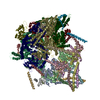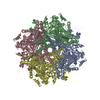+ Open data
Open data
- Basic information
Basic information
| Entry | Database: PDB / ID: 60000000000 | ||||||||||||||||||||||||||||||||||||
|---|---|---|---|---|---|---|---|---|---|---|---|---|---|---|---|---|---|---|---|---|---|---|---|---|---|---|---|---|---|---|---|---|---|---|---|---|---|
| Title | PTEX Core Complex in the Engaged (Extended) State | ||||||||||||||||||||||||||||||||||||
 Components Components |
| ||||||||||||||||||||||||||||||||||||
 Keywords Keywords | PROTEIN TRANSPORT / Translocon / Membrane Protein / ATPase | ||||||||||||||||||||||||||||||||||||
| Function / homology |  Function and homology information Function and homology informationPTEX complex / apical complex / symbiont-containing vacuole / translocation of peptides or proteins into host cell cytoplasm / symbiont-containing vacuole membrane / response to unfolded protein / cellular response to heat / response to heat / ATP hydrolysis activity / ATP binding / cytoplasm Similarity search - Function | ||||||||||||||||||||||||||||||||||||
| Biological species |   | ||||||||||||||||||||||||||||||||||||
| Method | ELECTRON MICROSCOPY / single particle reconstruction / cryo EM / Resolution: 4.16 Å | ||||||||||||||||||||||||||||||||||||
 Authors Authors | Ho, C. / Lai, M. / Zhou, Z.H. | ||||||||||||||||||||||||||||||||||||
| Funding support |  United States, 11items United States, 11items
| ||||||||||||||||||||||||||||||||||||
 Citation Citation |  Journal: Nature / Year: 2018 Journal: Nature / Year: 2018Title: Malaria parasite translocon structure and mechanism of effector export. Authors: Chi-Min Ho / Josh R Beck / Mason Lai / Yanxiang Cui / Daniel E Goldberg / Pascal F Egea / Z Hong Zhou /  Abstract: The putative Plasmodium translocon of exported proteins (PTEX) is essential for transport of malarial effector proteins across a parasite-encasing vacuolar membrane into host erythrocytes, but the ...The putative Plasmodium translocon of exported proteins (PTEX) is essential for transport of malarial effector proteins across a parasite-encasing vacuolar membrane into host erythrocytes, but the mechanism of this process remains unknown. Here we show that PTEX is a bona fide translocon by determining structures of the PTEX core complex at near-atomic resolution using cryo-electron microscopy. We isolated the endogenous PTEX core complex containing EXP2, PTEX150 and HSP101 from Plasmodium falciparum in the 'engaged' and 'resetting' states of endogenous cargo translocation using epitope tags inserted using the CRISPR-Cas9 system. In the structures, EXP2 and PTEX150 interdigitate to form a static, funnel-shaped pseudo-seven-fold-symmetric protein-conducting channel spanning the vacuolar membrane. The spiral-shaped AAA+ HSP101 hexamer is tethered above this funnel, and undergoes pronounced compaction that allows three of six tyrosine-bearing pore loops lining the HSP101 channel to dissociate from the cargo, resetting the translocon for the next threading cycle. Our work reveals the mechanism of P. falciparum effector export, and will inform structure-based design of drugs targeting this unique translocon. | ||||||||||||||||||||||||||||||||||||
| History |
|
- Structure visualization
Structure visualization
| Movie |
 Movie viewer Movie viewer |
|---|---|
| Structure viewer | Molecule:  Molmil Molmil Jmol/JSmol Jmol/JSmol |
- Downloads & links
Downloads & links
- Download
Download
| PDBx/mmCIF format |  6e10.cif.gz 6e10.cif.gz | 1.2 MB | Display |  PDBx/mmCIF format PDBx/mmCIF format |
|---|---|---|---|---|
| PDB format |  pdb6e10.ent.gz pdb6e10.ent.gz | 1 MB | Display |  PDB format PDB format |
| PDBx/mmJSON format |  6e10.json.gz 6e10.json.gz | Tree view |  PDBx/mmJSON format PDBx/mmJSON format | |
| Others |  Other downloads Other downloads |
-Validation report
| Summary document |  6e10_validation.pdf.gz 6e10_validation.pdf.gz | 1.8 MB | Display |  wwPDB validaton report wwPDB validaton report |
|---|---|---|---|---|
| Full document |  6e10_full_validation.pdf.gz 6e10_full_validation.pdf.gz | 1.8 MB | Display | |
| Data in XML |  6e10_validation.xml.gz 6e10_validation.xml.gz | 177.4 KB | Display | |
| Data in CIF |  6e10_validation.cif.gz 6e10_validation.cif.gz | 271.4 KB | Display | |
| Arichive directory |  https://data.pdbj.org/pub/pdb/validation_reports/e1/6e10 https://data.pdbj.org/pub/pdb/validation_reports/e1/6e10 ftp://data.pdbj.org/pub/pdb/validation_reports/e1/6e10 ftp://data.pdbj.org/pub/pdb/validation_reports/e1/6e10 | HTTPS FTP |
-Related structure data
| Related structure data |  8951MC  8952C  6e11C M: map data used to model this data C: citing same article ( |
|---|---|
| Similar structure data |
- Links
Links
- Assembly
Assembly
| Deposited unit | 
|
|---|---|
| 1 |
|
- Components
Components
-Protein , 4 types, 27 molecules 123456BAGFEDCagfedcbhijklmn
| #1: Protein | Mass: 106277.125 Da / Num. of mol.: 6 / Source method: isolated from a natural source Source: (natural)   References: UniProt: Q8IIJ8 #2: Protein | Mass: 33458.707 Da / Num. of mol.: 7 / Source method: isolated from a natural source Source: (natural)  References: UniProt: Q8IKC8 #3: Protein | Mass: 22593.170 Da / Num. of mol.: 8 / Source method: isolated from a natural source Source: (natural)   References: UniProt: Q8ILA1 #5: Protein | Mass: 4954.098 Da / Num. of mol.: 6 / Source method: isolated from a natural source / Source: (natural)  |
|---|
-Protein/peptide / Non-polymers , 2 types, 13 molecules 0

| #4: Protein/peptide | Mass: 1294.587 Da / Num. of mol.: 1 / Source method: isolated from a natural source / Source: (natural)  |
|---|---|
| #6: Chemical | ChemComp-AGS / |
-Details
| Has protein modification | Y |
|---|
-Experimental details
-Experiment
| Experiment | Method: ELECTRON MICROSCOPY |
|---|---|
| EM experiment | Aggregation state: PARTICLE / 3D reconstruction method: single particle reconstruction |
- Sample preparation
Sample preparation
| Component | Name: Plasmodium Translocon of Exported Proteins (PTEX) Core Complex Type: COMPLEX / Entity ID: #1-#5 / Source: NATURAL |
|---|---|
| Source (natural) | Organism:  |
| Buffer solution | pH: 7.4 |
| Specimen | Embedding applied: NO / Shadowing applied: NO / Staining applied: NO / Vitrification applied: YES Details: PTEX core complex purified from P. falciparum parasites cultured in human erythrocytes |
| Specimen support | Grid material: COPPER |
| Vitrification | Instrument: FEI VITROBOT MARK IV / Cryogen name: ETHANE |
- Electron microscopy imaging
Electron microscopy imaging
| Experimental equipment |  Model: Titan Krios / Image courtesy: FEI Company |
|---|---|
| Microscopy | Model: FEI TITAN KRIOS |
| Electron gun | Electron source:  FIELD EMISSION GUN / Accelerating voltage: 300 kV / Illumination mode: FLOOD BEAM FIELD EMISSION GUN / Accelerating voltage: 300 kV / Illumination mode: FLOOD BEAM |
| Electron lens | Mode: BRIGHT FIELD / Nominal magnification: 130000 X / Nominal defocus max: 4000 nm / Nominal defocus min: 2000 nm / Calibrated defocus min: 1500 nm / Calibrated defocus max: 4000 nm / Cs: 2.7 mm / C2 aperture diameter: 70 µm / Alignment procedure: COMA FREE |
| Specimen holder | Cryogen: NITROGEN / Specimen holder model: FEI TITAN KRIOS AUTOGRID HOLDER |
| Image recording | Average exposure time: 10 sec. / Electron dose: 60 e/Å2 / Detector mode: COUNTING / Film or detector model: GATAN K2 SUMMIT (4k x 4k) |
| EM imaging optics | Energyfilter name: GIF Quantum LS / Energyfilter slit width: 20 eV |
| Image scans | Width: 3710 / Height: 3838 / Movie frames/image: 50 / Used frames/image: 2-50 |
- Processing
Processing
| EM software |
| ||||||||||||||||||||||||||||||||||||
|---|---|---|---|---|---|---|---|---|---|---|---|---|---|---|---|---|---|---|---|---|---|---|---|---|---|---|---|---|---|---|---|---|---|---|---|---|---|
| CTF correction | Type: PHASE FLIPPING AND AMPLITUDE CORRECTION | ||||||||||||||||||||||||||||||||||||
| Particle selection | Num. of particles selected: 1508462 | ||||||||||||||||||||||||||||||||||||
| 3D reconstruction | Resolution: 4.16 Å / Resolution method: FSC 0.143 CUT-OFF / Num. of particles: 72866 / Symmetry type: POINT | ||||||||||||||||||||||||||||||||||||
| Atomic model building | Protocol: AB INITIO MODEL / Space: REAL |
 Movie
Movie Controller
Controller










 PDBj
PDBj



